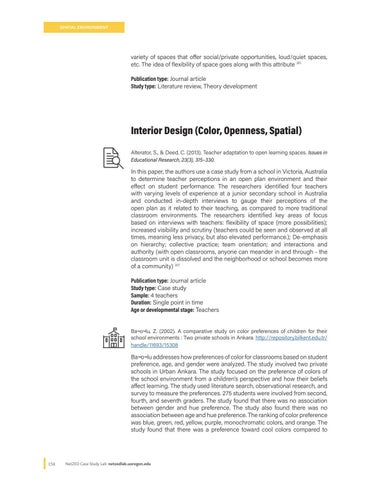SPATIAL ENVIRONMENT
variety of spaces that offer social/private opportunities, loud/quiet spaces, etc. The idea of flexibility of space goes along with this attribute 311. Publication type: Journal article Study type: Literature review, Theory development
Interior Design (Color, Openness, Spatial) Alterator, S., & Deed, C. (2013). Teacher adaptation to open learning spaces. Issues in Educational Research, 23(3), 315–330.
In this paper, the authors use a case study from a school in Victoria, Australia to determine teacher perceptions in an open plan environment and their effect on student performance. The researchers identified four teachers with varying levels of experience at a junior secondary school in Australia and conducted in-depth interviews to gauge their perceptions of the open plan as it related to their teaching, as compared to more traditional classroom environments. The researchers identified key areas of focus based on interviews with teachers: flexibility of space (more possibilities); increased visibility and scrutiny (teachers could be seen and observed at all times, meaning less privacy, but also elevated performance.); De-emphasis on hierarchy; collective practice; team orientation; and interactions and authority (with open classrooms, anyone can meander in and through - the classroom unit is dissolved and the neighborhood or school becomes more of a community) 317 Publication type: Journal article Study type: Case study Sample: 4 teachers Duration: Single point in time Age or developmental stage: Teachers Başoğlu, Z. (2002). A comparative study on color preferences of children for their school environments : Two private schools in Ankara. http://repository.bilkent.edu.tr/ handle/11693/15308
Başoğlu addresses how preferences of color for classrooms based on student preference, age, and gender were analyzed. The study involved two private schools in Urban Ankara. The study focused on the preference of colors of the school environment from a children’s perspective and how their beliefs affect learning. The study used literature search, observational research, and survey to measure the preferences. 275 students were involved from second, fourth, and seventh graders. The study found that there was no association between gender and hue preference. The study also found there was no association between age and hue preference. The ranking of color preference was blue, green, red, yellow, purple, monochromatic colors, and orange. The study found that there was a preference toward cool colors compared to
154
NetZED Case Study Lab netzedlab.uoregon.edu

